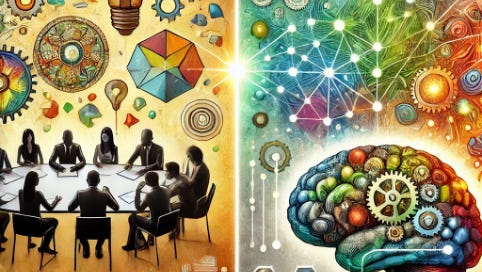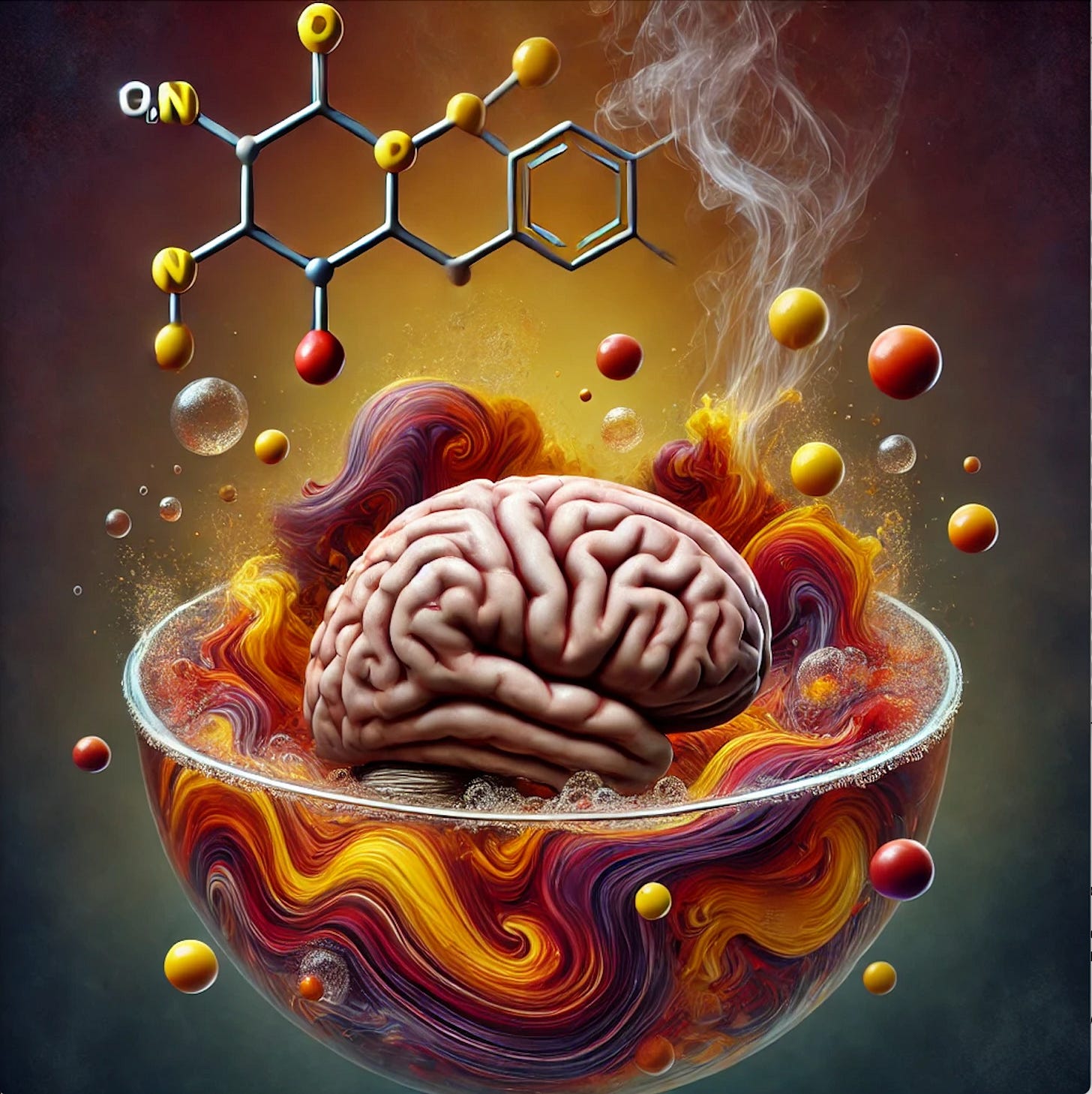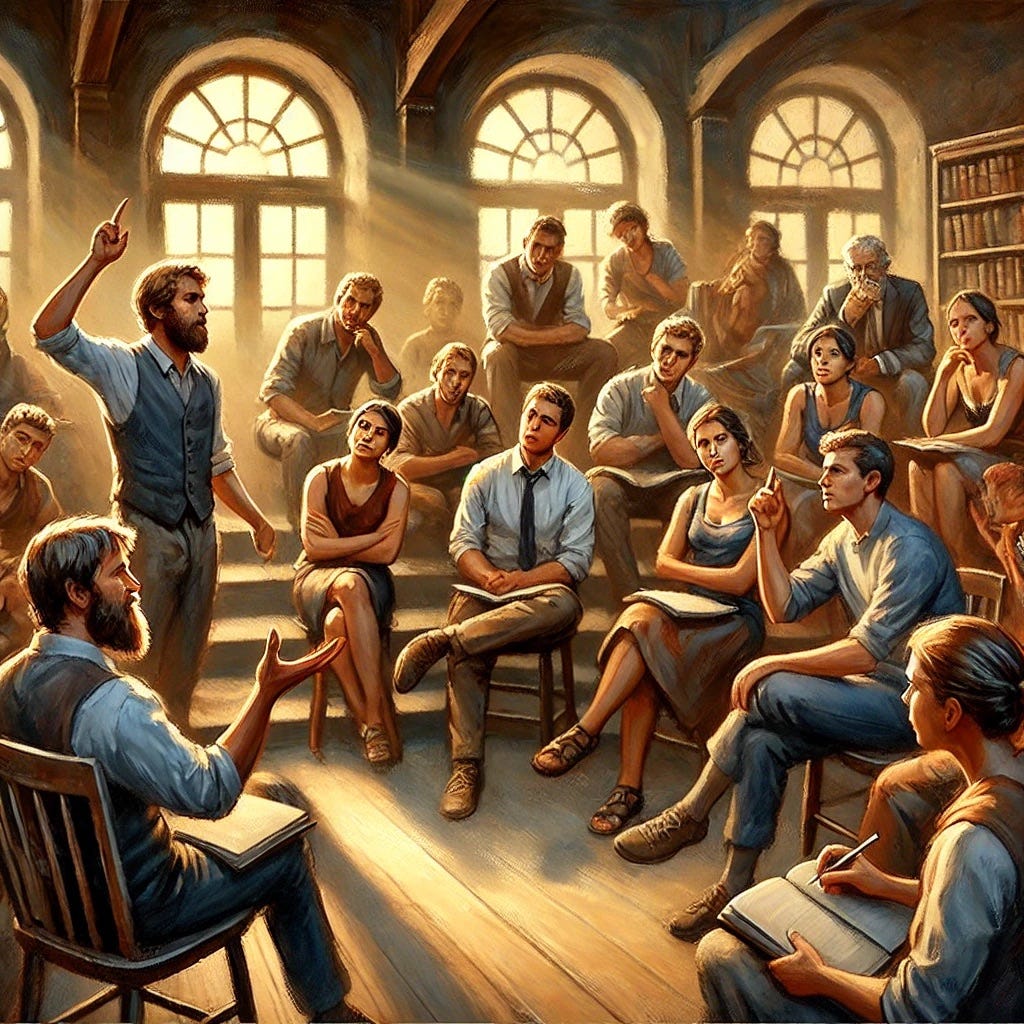Disruptive Change and Organisational Success (PART 3 of 3)
Why Leaders Need Neuroscience to Lead Effectively Today
In PART 1 we addressed clarity of mind in a VUCA world, the stress response, Daniel Kahneman’s System 1 and 2 thinking; the illusion of increased workplace productivity; how stress impacts creativity and decision-making.
In PART 2 we addressed what the aviation industry can teach organisations, cognitive flexibility and habitual cognition, neuroscience basics for organisations, and more about what stress does to the brain but good news to counter it - using our body and mind.
In PART 3 we’re going to address some of the solutions that can drive success in organisations despite the disruptive change we’re faced with.
One brain working alone - or a collection of brains?
This is also where the idea of ‘unbound’ or ‘distributed cognition‘ can become very useful, which is the opposite of ‘brain bound cognition.’
The former refers to many different brains collaborating – sharing ideas – whereas the latter refers to the lonely process of one brain thinking alone.
Unfortunately, established groups of people, such as teams within organisations and leadership groups, become unable to think differently because they become used to thinking with the groups’ brains and form group-think habits or patterns.
This is why outside support in the pursuit of critical thinking is essential.
When ones decision-making capacity is compromised due to the effects of stress on cognition, it is very helpful to already have a trusted team of ‘unbound brains’ to support clearer, critical thinking.
When we are stressed, we need others to weigh in on important decisions because our physiology is interfering with our neurophysiology.
When one looks at the decisions that many leaders are making currently, it isn't hard to see that many of them are making decisions that are not based on critical thinking and sound reasoning.
[Now that you’re aware of how the brain responds to chronic stress wouldn't you also like to see all political leaders have their cognitive health and cortisol levels checked regularly so we can be sure we’re being led by people whose brains are working optimally and who aren't making decisions using habitual, ‘exploitive’ thinking? See PART 1 for an explanation about ‘exploratory’ vs. ‘exploitive’ behavior.]
Let’s think about thinking …
The brain changes the way we see things, and the way we see things changes the brain due to the brain's capacity to change via neuroplasticity.
When stressed, we focus on work and the threats we face, but we miss seeing the opportunities, and it is the opportunities that help organisations thrive – avoiding threats to just survive is no longer enough.
We must survive AND thrive.
Unfortunately, it is more challenging to ‘switch off’ from work today than it was even a decade ago.
Technology has meant that we’re always ‘on,’ and even if we’re not replying to emails and working on projects during non-work hours, then we are exposed to vast quantities of information about the world and what’s happening in it via the many digital feeds we now have funnelling into us on a daily basis, all of which makes ‘switching off’ extremely difficult, and requires discipline and strong will.
Working from home (WFH) has only compounded this issue as the work/life lines have become even more blurred and overlapping.
There’s no longer a sense of ‘switching off’ like in the ’olden days,’ when there was a clear distinction between work and home.
The 24/7 exposure to information about the above leaves many people feeling as if they’re always on, and home and ‘non-work’ time isn’t a respite from paying attention to what’s going on in the world.
It adds an extra ladle or two to the cortisol soup our neurons are already marinating in.
Modern Burnout
The sense of ‘burnout’ that many people now feel is, however, not simply related to work anymore, where the term was originally coined.
Many people feel burned out by modern life – the complexity they are now living with and the sense of not having much control over how their lives are unfolding.
As per the images below, we used to have a clear distinction between our work and personal lives (the 1st image) but today the boundaries are blurred (the 2nd image).
Modern Burnout is prevalent today, and is the result of this and other, intersecting factors, such as:
· Economic challenges
· Environmental changes/challenges/fear
· Global unrest
· Mental health challenges
· Political unrest
· Strange ‘socio-political’ environment
· Technologies reach into all aspects of life - grocery store shopping, dating, work, relaxation etc
· Unrelenting change
Unless we make a concerted and ongoing effort to avoid being exposed to the tsunami of information that technology has made available to us, like a ‘buffet of overwhelm,’ we will find ourselves feeling increasingly stressed and overwhelmed.
Digital dementia is a term now used by researchers who are examining what the nearly-constant digital immersion during our waking hours is doing to our brains. The evidence suggests that we now have significantly reduced attention spans and our memory is also being impacted, which we addressed in PART 2. Our ability to regulate our emotions is also linked to increased screen time. (1) (2)
What about how we’re ‘feeling?’
Poor emotional regulation, what Professor Gad Saad calls “Emotional Incontinence,” seems to be prevalent in society today. (3)
This is likely in part due to the effects of stress, in which people are unable to mentally step back from their stress to gain a larger perspective of the situation. As mentioned in PART 2, high levels of stress lead to reduced PFC activity and heightened amygdala activity, both of which contribute to emotional dysregulation.
Another factor that needs addressing is the inability for many people to tolerate uncomfortable emotions. This may be more prevalent in younger generations due to what Greg Lukianoff and Jonathan Haidt addressed in their book ‘The Coddling of the American Mind.’ (4)
A confluence of factors a few decades ago led to parents and educational institutions protecting their charges from any unpleasantness, whether physical discomfort which results from normal rough and tumble play, essential in childhood, to colleges preventing their students from listening to academics and politicians that didn’t agree with students (and many academics) current worldview. (5)
Can we tolerate uncomfortable feelings and thoughts?
In a world where exponential ambiguity and change is the new normal, an inability to tolerate feeling uncomfortable is a major deterrent to creative and critical thinking, and therefore success.
In addition, the ability to tolerate discomfort is an essential component of both cognitive and stress resilience.
Unfortunately, because we are increasingly living with uncertainty, which leads to discomfort, many people may need to be taught how to manage feeling uncomfortable because society no longer supports its natural development.
Online algorithmically-fueled echo-chambers and personalised ‘feeds’ have also likely contributed to many being unable to tolerate dissenting perspectives.
This is also likely due to the unforeseen impacts of technology on brain development, specifically the PFC, which is involved in emotional regulation and thus inhibiting emotional outbursts. Data supports this perspective, as some evidence links the inability to regulate emotions with increased screen time in children, adolescents and young adults. (1) (6) (7)
More to ponder …
Do younger generations feel more entitled to a life of comfort and ease because of who their online role models are? A survey of over 2,000 Gen Z social media users revealed that over 50% of them want to be ‘influencers,’ who seem to live a life worthy of emulation. (8)
Again, these results suggest an emotional reaction versus a considered one.
We need to (re-) learn how to take a step back, to gain a more holistic view - pull ourselves up and out of the rat race so we can observe and reflect calmly.
It’s hard to do this without support - if people could do this with ease they’d have done so successfully.
Nana Abban mentions ‘practise the pause’ and Marcus speaks about ‘slowing down to speed up. (9)
Dr Iain McGilchrist states that ‘Our talent for division, for seeing the parts, is of staggering importance – second only to our capacity to transcend it, in order to see the whole.’ (10)
Delia says ‘step back physically, to allow the brain to follow suit, to gain perspective.’
We need both the capacity to see the minutiae and to gain perspective from stepping back - and this is often lacking in organisations because of ‘group-thinking’ habits and an unwillingness to face uncomfortable facts.
Once again, support from outside an organisation is critical to introduce and teach critical thinking.
In PART 1 we addressed how our brains operate and interpret information using System One and Two thinking.
We are however living in a world where we’re regularly exposed to ideas where emotion is used to convey information.
It is therefore likely that many people are using System One responses more often than Systems Two thinking, which then becomes a robust neural pathway due to consistent use.
Link this to under-optimised brain development due to being protected from discomfort and less-than-optimal brain development due to tech-immersion, and the need for training in critical thinking becomes obvious.
Can we hold two different ideas in our mind at once?
‘Cognitive dissonance’ is the term used to describe what the brain experiences when it holds two opposing ideas simultaneously. Scott Fitzgerald is quoted as saying that ‘the test of a first-rate intelligence is the ability to hold two opposing ideas in mind at the same time and still retain the ability to function.’ (11)
Needless to say, this seems to be an under-experienced phenomenon in the world we’re currently living in. For all the reasons noted above it’s a cognitive skill that should be introduced at the dinner table, built upon at school, and embraced in higher education.
Unfortunately, too many parents have also been seduced by technology and aren't providing examples to their children of how to use technology wisely. Parents who have been sucked into feeling comfortable with their own perspectives cannot be expected to introduce their children to cognitive dissonance.
In addition, many parents' stress levels are also heightened, which leads to them responding in instinctual, habitual ways to parenting and general life demands, as mentioned in PART 1.
You now know that brains marinating in stress hormones can’t think critically or creatively.
By extension, organisational leaders expecting them to be engaged and productive are fooling themselves.
Teaching critical thinking and the ability to tolerate uncomfortable feelings within organisations is the work-around we need to foster until it once again becomes part of the fabric of education, because the human brain naturally reverts to biases because neural energy is expensive, and people’s egos are linked to their identity.
Neural energy and change … the details matter!
All change involves brain change, and there’s a high metabolic cost to pay within our sensitive and sophisticated brains.
If you want a deeper dive into ‘neural energy’ please click the button below:
We use less neural energy when we simply follow a habitual action or thought process - this is the reason habits are so useful. They help the brain conserve energy because there's nowhere in the brain to store energy.
Unfortunately, the brain uses more nutrients when it is stressed, which impacts many neurological functions, including brain-energy levels, the ability to think critically, creatively and sleep well. Again, this is seldom addressed because most leaders never consider what the brain requires to function optimally.
In summary
A variety of confluencing personal, national and global factors have led to ongoing uncertainty and a sense of no control over outcomes among many millions of people.
The resultant high stress levels have contributed directly to poor mental health, low levels of engagement, burnout, poor decision-making and lack of creativity.
To address these and other related challenges we need to start thinking from first principles.
Whether in the workplace, at home, our community, or our nation, it is now time to think differently. To challenge what we see and hear, to value different perspectives but not shy away from engaging with each other.
We must not fall foul of oblivious compliance, however hard it may be and however much our brain tries to disengage.
We must overcome our habitual thinking patterns to optimise the use of our amazing cognitive capacity.
In PART 1 we addressed clarity of mind in a VUCA world, the stress response, Daniel Kahneman’s System 1 and 2 thinking; the illusion of increased workplace productivity; how stress impacts creativity and decision-making.
In PART 2 we addressed what the aviation industry can teach organisations, cognitive flexibility and habitual cognition, neuroscience basics for organisations, and more about what stress does to the brain but good news to counter it - using our body, and mind.
Please contact me and Marcus if you’d like us to help you, your organization and teams learn more about critical thinking.
If you enjoyed this series, please subscribe to get upcoming articles delivered straight into your inbox.
References
(1) Manwell LA, Tadros M, Ciccarelli TM, Eikelboom R. (2022) Digital dementia in the internet generation: excessive screen time during brain development will increase the risk of Alzheimer's disease and related dementias in adulthood. J Integr Neurosci;21(1):28.
(2) Moledina S, Khoja A. (2018) Letter to the Editor: Digital Dementia-Is Smart Technology Making Us Dumb? Ochsner J;18(1):12.
(3) Saad, Gad. (2020) The Parasitic Mind: How Infectious Ideas Are Killing Common Sense Regnery Publishing.
(4) Lukianoff, G., & Haidt, J. (2018). The coddling of the American mind: how good intentions and bad ideas are setting up a generation for failure. Penguin Press.
(5) Abigail Shrier (2024) Bad Therapy: Why the Kids Aren't Growing Up; Sentinel.
(6) Radesky JS, Kaciroti N, Weeks HM, Schaller A, Miller AL. (2023) Longitudinal Associations Between Use of Mobile Devices for Calming and Emotional Reactivity and Executive Functioning in Children Aged 3 to 5 Years. JAMA Pediatr;177(1):62–70;
(7) Yang H, Wang Z, Elhai JD, Montag C. (2022) The relationship between adolescent emotion dysregulation and problematic technology use: Systematic review of the empirical literature. J Behav Addict;11(2):290-304.
(8) https://pro.morningconsult.com/analyst-reports/influencer-marketing-trends-report?utm_source=mc_comms_outreach&utm_medium=mc_comms_referral&utm_campaign=influencer_report
(9) https://uk.linkedin.com/in/nana-abban-2a43b460?trk=public_post_comment-text
(10) https://assets-global.website-files.com/624067c9856247a83a3bea05/64468b3a63698e6686506f66_The%20ONE%20and%20the%20Many.pdf#:~:text=%27Our%20talent%20for%20division%2C%20for%20seeing%20the,reductionism%20within%20holism%2C%20a%20state%20of%20deep.
(11) Copyright 1945, The Crack-Up by F Scott Fitzgerald; With Other Uncollected Pieces, Note-Books and Unpublished Letters; (Together with Letters to Fitzgerald from Gertrude Stein; Edith Wharton; T. S. Eliot; Thomas Wolfe and John Dos Passos), Edited by Edmund Wilson, “The Crack-Up” by F Scott Fitzgerald, (Essay dated February 1936), Start Page 69, Quote Page 69, First published as New Directions Paperback Number 54 in 1956, New Directions, Books, New York. (Verified on paper).












